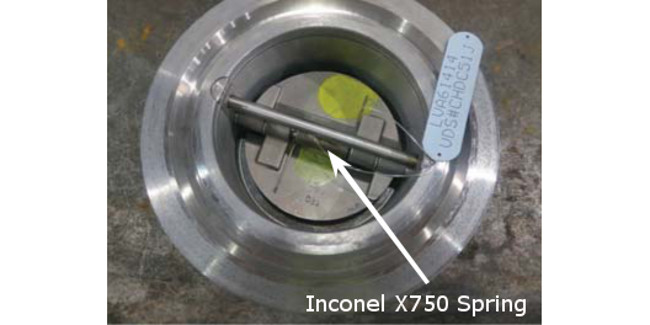The external grooves such as those located on the Ring Type Joint (RTJ) faces of valve body flanges in carbon steel material are overlaid with Inconel 625 to avoid external crevice corrosion in offshore projects.
Galling and friction: Galling is a form of wear caused by two surfaces rubbing together. There are various strategies to avoid galling such as lubrication, reducing the roughness and creating a hardness differential between two sliding surfaces. The threaded plug shown in Figure 4 is used to drain the fluid accumulated in the body cavity of the ball valve. The treaded part of the plug creates friction and galling with the body of the valve during opening and closing. Thus, the plug material is chosen in Inconel 625 to create a hardness difference with the body of the valve and consequently reduce galling and friction.
Mechanical strength: Actuated valves create a high load on the valve stem. Therefore the stem in actuated valves should be manufactured of a high strength material such as Inconel 718 for carbon steel, stainless steel 316 and 22Cr duplex body valves. Inconel 718 may also be used for ball and bolting components, especially in subsea valves.
 Figure 5. Dual plate check valve in 22Cr duplex with Inconel X750 spring
Figure 5. Dual plate check valve in 22Cr duplex with Inconel X750 spring
Cycling and fatigue stress: A spring is often used in check valves to move the disk back to its original position and close the valve. Many check valves experience a high rate of opening and closing (cycling). For this reason, Inconel X750 spring material is widely specified for check valves due to its good resistance to cycling and fatigue stress. Figure 5 illustrates a dual plate check valve with a carbon steel body and martensitic stainless disks which are closed through the Inconel X750 spring.
Nickel alloy materials
Inconel 625 (Alloy 625) is a nickel-based alloy with high corrosion resistance and mechanical strength. This material has 22% chromium, 9% molybdenum, and around 58% nickel. The strength of this material is derived from the stiffening effect of Molybdenum and Niobium on its nickel-chromium matrix. Relatively high Molybdenum content.
Inconel 718 is a high-strength, relatively highly corrosion resistant, nickel-chromium alloy. This material has approximately 52.5% nickel, 20% chromium and 3% molybdenum.
Fabrication and welding of this alloy are easy, and it has good resistance to fatigue. Two common heat treatments for this alloy are solution annealing and age hardening.
Inconel X750 is another nickel-chromium alloy with high corrosion resistance and high strength. This alloy contains at least 70% nickel and on average 15% chromium. Different mechanical properties may be achieved through different heat treatments for this alloy. This alloy is an economical choice widely used in various industries in addition to oil and gas, such as gas turbines and rocket engines.
Conclusion and recommendation
Inconel alloys such as Inconel 625, 718 and X750 are widely for piping and valves in the offshore sector. The body, bonnet, seat, ball, bolt, plug and spring of ball valves are frequently manufactured from the alloys mentioned. Although nickel alloys are used widely for both internal and external corrosion resistance, they have different applications such as increasing mechanical strength, reducing friction and galling, facilitating cycling and mitigating fatigue stress.

